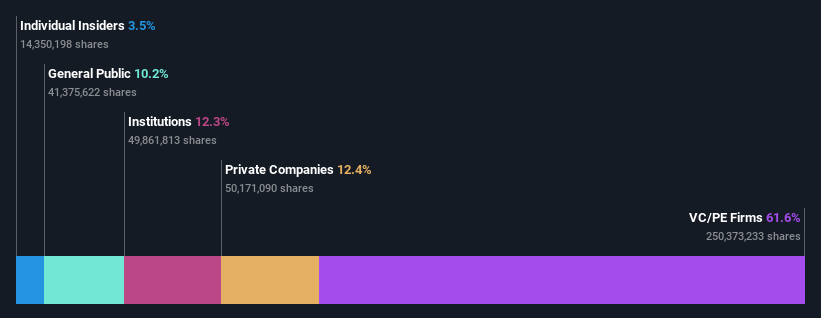Key Insights
-
Significant control over GoodRx Holdings by private equity firms implies that the general public has more power to influence management and governance-related decisions
-
The top 2 shareholders own 53% of the company
Every investor in GoodRx Holdings, Inc. (NASDAQ:GDRX) should be aware of the most powerful shareholder groups. We can see that private equity firms own the lion’s share in the company with 62% ownership. Put another way, the group faces the maximum upside potential (or downside risk).
As a result, private equity firms were the biggest beneficiaries of last week’s 15% gain.
Let’s take a closer look to see what the different types of shareholders can tell us about GoodRx Holdings.
Check out our latest analysis for GoodRx Holdings
What Does The Institutional Ownership Tell Us About GoodRx Holdings?
Many institutions measure their performance against an index that approximates the local market. So they usually pay more attention to companies that are included in major indices.
GoodRx Holdings already has institutions on the share registry. Indeed, they own a respectable stake in the company. This suggests some credibility amongst professional investors. But we can’t rely on that fact alone since institutions make bad investments sometimes, just like everyone does. If multiple institutions change their view on a stock at the same time, you could see the share price drop fast. It’s therefore worth looking at GoodRx Holdings’ earnings history below. Of course, the future is what really matters.
GoodRx Holdings is not owned by hedge funds. Our data shows that Silver Lake Technology Management, L.L.C. is the largest shareholder with 32% of shares outstanding. In comparison, the second and third largest shareholders hold about 21% and 12% of the stock.
After doing some more digging, we found that the top 2 shareholders collectively control more than half of the company’s shares, implying that they have considerable power to influence the company’s decisions.
While it makes sense to study institutional ownership data for a company, it also makes sense to study analyst sentiments to know which way the wind is blowing. There are plenty of analysts covering the stock, so it might be worth seeing what they are forecasting, too.
Insider Ownership Of GoodRx Holdings
While the precise definition of an insider can be subjective, almost everyone considers board members to be insiders. Management ultimately answers to the board. However, it is not uncommon for managers to be executive board members, especially if they are a founder or the CEO.
Most consider insider ownership a positive because it can indicate the board is well aligned with other shareholders. However, on some occasions too much power is concentrated within this group.
We can report that insiders do own shares in GoodRx Holdings, Inc.. This is a big company, so it is good to see this level of alignment. Insiders own US$93m worth of shares (at current prices). If you would like to explore the question of insider alignment, you can click here to see if insiders have been buying or selling.
General Public Ownership
The general public– including retail investors — own 10% stake in the company, and hence can’t easily be ignored. This size of ownership, while considerable, may not be enough to change company policy if the decision is not in sync with other large shareholders.
Private Equity Ownership
With a stake of 62%, private equity firms could influence the GoodRx Holdings board. Some might like this, because private equity are sometimes activists who hold management accountable. But other times, private equity is selling out, having taking the company public.
Private Company Ownership
We can see that Private Companies own 12%, of the shares on issue. It’s hard to draw any conclusions from this fact alone, so its worth looking into who owns those private companies. Sometimes insiders or other related parties have an interest in shares in a public company through a separate private company.
Next Steps:
I find it very interesting to look at who exactly owns a company. But to truly gain insight, we need to consider other information, too. Consider risks, for instance. Every company has them, and we’ve spotted 3 warning signs for GoodRx Holdings you should know about.
Ultimately the future is most important. You can access this free report on analyst forecasts for the company.
NB: Figures in this article are calculated using data from the last twelve months, which refer to the 12-month period ending on the last date of the month the financial statement is dated. This may not be consistent with full year annual report figures.
Have feedback on this article? Concerned about the content? Get in touch with us directly. Alternatively, email editorial-team (at) simplywallst.com.
This article by Simply Wall St is general in nature. We provide commentary based on historical data and analyst forecasts only using an unbiased methodology and our articles are not intended to be financial advice. It does not constitute a recommendation to buy or sell any stock, and does not take account of your objectives, or your financial situation. We aim to bring you long-term focused analysis driven by fundamental data. Note that our analysis may not factor in the latest price-sensitive company announcements or qualitative material. Simply Wall St has no position in any stocks mentioned.



